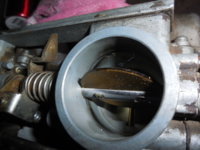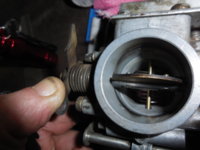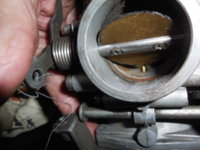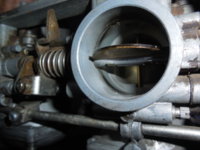....there is one other possibility Bob.....
Let me preface by saying that my Lucille starts very predictably on the first or second push of the button (if I remember to push the enrichener lever - oh yeah, and turn on the danged petcocks) and she idles between 1200 and 1600 rpm according to her mood. She backfires softly when I decelerate and occasionally a cylinder will drop out for a moment or two on cold mornings. If I ride the he!! out of her, she gets about 48 MPG and if I baby her, she gets about 51 MPG, so one might think that she has a few tuning problems.
...but she is, afterall, a 41 year old motorcycle with what can only be seen as a very primitive set of carburetors. She has no O2 sensor, no TPS, no MAP - no engine electronics or monitoring at all. Heck - she doesn't even have an oil pressure sensor.
I wonder if we're not being perhaps just a bit too picky about how these old bikes run....
My 2007 Honda ST1300 has closed loop EFI and she starts and runs EXACTLY the same - every single time I push the button (the ST doesn't even have a kick starter). The mileage never varies and she produces the same power rain or shine, night or day - no matter what.
Anyhow, I have decided that my dear old Lucille runs as well as she's going to, and I'm happy.
BTW - I am not, for a moment, suggesting that we give up on troubleshooting or correcting obvious flaws like fuel or oil leaks etc - or the type of air leak that Mailman tracked down and fixed so effectively last week.
However, as I recall it, back in 1978, my three year old, 6000 mile 1975 XS650B backfired a little, the odd time. As for odd occurrences, I do recall one very tense night ride from Sault Ste. Marie to Wawa, Ontario (truly a desolate 130 mile stretch of wilderness road) when the B-model simply quit for a few seconds for no apparent reason. I'll never forget that gut wrenching feeling of silence and NO power while my speed dropped from 60 down to about 10 mph.... But the bike picked up just before I pulled off the road in the dark at 1:45 AM, 50 miles from any town, and I made it to my destination (and very horney girlfriend

) just fine.
When I arrived in Wawa (after some activities which will not further be described) I checked the bike over thoroughly, but never did figure out what happened to cause her to cut-out in the middle of nowhere like that. She did the same damned thing several more times over the next few years, but needless to say - she never did it in daylight, nor did she ever do it when situated less than 100 km from a town. I did some very long trips on my B-model, and she always got me there - but there was always a bit of...adventure in the trip.
Anyhow, I would guess that nowadays, our XS650s are seldom used for really long haul trips - but the older owners can, I am sure, confirm that they are quite capable of such excursions. The key point is, these are old bikes and they really do use pretty primitive technology - so, I am pretty relaxed about the level of perfection I expect.
Pete





















